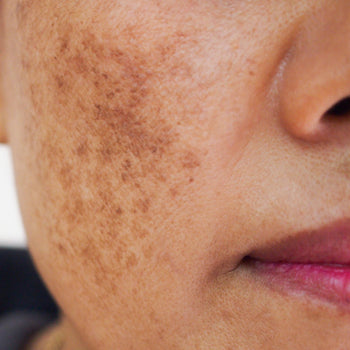If you’ve ever dealt with dark spots, uneven patches, or lingering marks after a breakout, you’re not alone. Hyperpigmentation is one of the most common skin concerns—and it can affect people of all skin tones and skin types.
While hyperpigmentation is usually harmless, it can be frustrating and emotionally draining, especially when it seems like nothing is working. The good news? Once you understand what’s happening beneath the surface, you can take gentle, effective steps to support your skin and gradually restore a smoother, more even complexion.
Let’s take a deeper look into what causes hyperpigmentation, the different types, and how you can care for your skin in a way that’s both safe and sustainable.
What Is Hyperpigmentation?
Hyperpigmentation refers to areas of the skin that become darker than your natural skin tone. This happens when melanin, the pigment responsible for skin color, is produced in excess or becomes unevenly distributed.
This overproduction can be triggered by sun exposure, inflammation, hormonal changes, or skin injury. Hyperpigmentation isn’t dangerous, but many people seek to reduce its appearance for smoother, clearer-looking skin.
What Causes Hyperpigmentation?
There are several reasons hyperpigmentation develops. Some of the most common include:
Sun Exposure
Ultraviolet (UV) rays stimulate the production of melanin as the skin’s way of protecting itself. Over time, this can result in sunspots or age spots—especially on areas frequently exposed to the sun, like the face, chest, and hands.
Post-Inflammatory Hyperpigmentation (PIH)
PIH occurs after the skin has been irritated or injured. Common triggers include acne, eczema, bug bites, or even cosmetic treatments. This form of hyperpigmentation is especially common in medium to deep skin tones.
Hormonal Changes (Melasma)
Melasma is often linked to hormonal fluctuations, particularly during pregnancy or with oral contraceptives. It typically appears in symmetrical patches on the face, and can become darker with sun exposure.
Skin Injuries
Cuts, burns, and even friction from masks or razors can result in pigmentation once the skin begins to heal—especially if the area becomes inflamed.
Types of Hyperpigmentation
Each form of hyperpigmentation may require a slightly different approach to care. Here are the most common types:
Sunspots (Solar Lentigines)
These appear as flat, brown or black spots in sun-exposed areas. They're associated with long-term sun damage and often increase with age.
Post-Inflammatory Hyperpigmentation (PIH)

Appears as dark spots or patches following skin trauma. The discoloration can be red, brown, or purple, depending on your skin tone and the depth of the damage.
Melasma

Characterized by larger, patchy areas of discoloration—usually on the cheeks, forehead, or upper lip. It’s often hormonally driven and can be more difficult to treat.
Freckles (Ephelides)

These small, flat brown marks are usually genetic, but they can darken or multiply with sun exposure. While technically a form of hyperpigmentation, freckles are often considered harmless and even desirable by some.
How to Care for Hyperpigmented Skin
Hyperpigmentation doesn’t clear overnight—but with consistency, care, and the right habits, you can see visible improvements over time. Here’s how:
1. Prioritize Sun Protection
Putting sunscreen on is the most important step in managing and preventing hyperpigmentation. UV rays worsen all types of pigmentation, so wearing a broad-spectrum SPF every day is essential—even when it's cloudy or you're indoors near windows. Reapply every 2 hours if you’re spending time outside.
Look for mineral sunscreens with zinc oxide or titanium dioxide if you have sensitive or reactive skin.
2. Be Gentle With Your Skin
Avoid over-exfoliating, picking at pimples, or using harsh products. Irritation and inflammation can lead to more discoloration, especially in deeper skin tones.
Use mild cleansers, hydrating serums, and barrier-repairing moisturizers to keep skin calm and supported.
3. Incorporate Targeted Brightening Ingredients
Several natural and science-backed ingredients can help lighten dark spots and even out skin tone over time:
Niacinamide – A gentle brightener that reduces melanin transfer, calms inflammation, and supports overall skin clarity.
Tranexamic Acid – Targets stubborn discoloration like melasma by interrupting the pathways that trigger excess pigment.
Arbutin – A natural alternative to hydroquinone that fades dark spots by inhibiting melanin production.
Tetrahexyldecyl Ascorbate – A stable, oil-soluble form of Vitamin C that brightens skin and protects against future damage.
Glycolic Acid – An alpha hydroxy acid (AHA) that exfoliates the surface, speeds up cell turnover, and fades pigmentation over time.
As always, for best results, pair brightening ingredients with daily SPF to protect your skin and maintain your glow.
4. Consistency Is Key
Hyperpigmentation can take 4–12 weeks or longer to fade, depending on the type and cause. Stick to your routine, avoid jumping between products, and track your skin’s progress over time.
5. Seek Professional Support When Needed
If you're not seeing improvement or if the discoloration worsens, a dermatologist or licensed esthetician can provide a proper diagnosis and treatment plan tailored to your skin's needs.
Dealing with hyperpigmentation can be discouraging—but it’s also a sign that your skin is responding to something deeper. Whether it's past breakouts, sun exposure, or hormonal shifts, your skin is doing its best to protect and repair itself.
The key is to respond with kindness, consistency, and education. Instead of harsh treatments or quick fixes, opt for a routine that prioritizes sun protection, gentle brightening, and long-term skin health.
When you understand what’s happening beneath the surface, you can empower your skin to heal naturally and beautifully.


